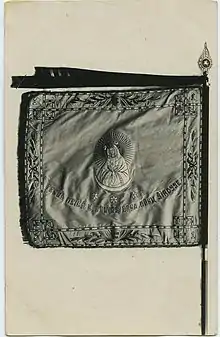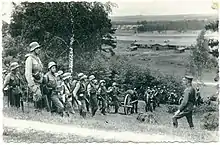1st Infantry Regiment (Lithuania)
The 1st Infantry Regiment (Lithuanian: 1-asis pėstininkų pulkas), later the 1st Infantry Regiment of the Lithuanian Grand Duke Gediminas (Lithuanian: 1-asis pėstininkų Lietuvos Didžiojo Kunigaikščio Gedimino pulkas) was an infantry regiment that served in the Lithuanian Army during the Interwar period.
| 1st Infantry Regiment of the Lithuanian Grand Duke Gediminas | |
|---|---|
| 1-asis pėstininkų Lietuvos Didžiojo Kunigaikščio Gedimino pulkas | |
 The regiment's flag with Our Lady of the Gate of Dawn on it. The regiment received the flag on 28 May 1926. | |
| Active | November 1, 1918 – October 26, 1940 |
| Country | |
| Branch | Lithuanian Army |
| Type | Infantry |
| Patron | Lithuanian Grand Duke Gediminas |
| Anniversaries | August 25 |
Formation
Vincas Grigaliūnas-Glovackis was made the regiment's commander on 1 November 1918.[1][2] The regiment began forming in Vilnius, although in a covert manner, because the occupying German authorities hampered the formation of the Lithuanian Army.[1] So, the regiment officially began forming only on 23 November 1918.[3][4][5] On December 7, the regiment included 31 officers and 59 soldiers.[1] In ten days, the number gradually increased to 33 officers, 3 military officials (Lithuanian: karo valdininkai), military doctor L. Janulionis and 87 soldiers.[6]
Lithuanian–Soviet War
By 11 February 1919, the regiment had 36 officers, 13 military officials, one military doctor and 678 soldiers.[7] At the time, the regiment was divided into two battalions, with the first one, led by the officer Ignas Musteikis, being composed of two infantry and one machine gun companies, while the remaining second battalion under officer Pranas Tamašauskas had just three infantry companies, that were not fully formed.[7] The 1st Infantry Regiment fought in the Battle of Alytus from 12 to 15 February, but suffered its first defeat there and had to retreat.[8] The regiment's casualties were one officer, i.e. the regimental commander, Antanas Juozapavičius, and a few soldiers killed, while 20 soldiers were captured as prisoners of war, some of whom escaped captivity.[9]
On April 25, the 1st Infantry Regiment included 57 officers, 21 military officials, and 1,640 soldiers.[10] At the end of August 1919, the regiment had 52 officers, 15 military officials, including three doctors and the military chaplain Catholic priest Pranas Garmus, and 1,733 soldiers, of whom 1,316 were trained.[11]
From 30 October 1919, the regiment's patron was the Grand Duke of Lithuania Gediminas.[4][12][13] Due to the regiment's merits in combat against Bolsheviks and because it began in Vilnius, founded by Gediminas according to legend, the regiment was accorded Gediminas' name.[12]
1920
On 15 December 1920, the regiment was staffed by 46 officers, 10 military officials, one military chaplain and 2,333 soldiers.[14] However, the regiment was lacking 26 officers and 537 soldiers until completion of the establishment.[14]


First Soviet Occupation
After Lithuania was occupied by the Soviet Union in 1940, on 2 July, the Lithuanian Army was renamed the Lithuanian People's Army.[16] The name of the unit's patron was removed on 24 July 1940.[4] Finally, the regiment was disbanded on 26 October 1940.[4]
References
- Rudokas 2007.
- Surgailis 2011, p. 8.
- Surgailis 2011, p. 11.
- Vydrina 2008.
- Ruzgas 1932, p. 136.
- Surgailis 2011, p. 17.
- Surgailis 2011, p. 32.
- Surgailis 2011, p. 47.
- Surgailis 2011, p. 48.
- Surgailis 2011, p. 58.
- Surgailis 2011, p. 96.
- Surgailis 2011, p. 106.
- tombal7 2020.
- Surgailis 2011, p. 133.
- Zareckas, Julius (26 February 2021). "Gintautas Surgailis. Pirmasis pėstininkų Didžiojo Lietuvos kunigaikščio Gedimino pulkas I - Ukmergės kultūros puslapiai". www.ukmergeskulturospuslapiai.lt (in Lithuanian). Archived from the original on 2021-09-16. Retrieved 2021-09-16.
- Surgailis 2011, p. 230.
Sources
- Lesčius, Vytautas (2004). Lietuvos Kariuomenė Nepriklausomybės Kovose 1918-1920 (PDF) (in Lithuanian). Vilnius. ISBN 9955-423-23-4.
{{cite book}}: CS1 maint: location missing publisher (link) - Rudokas, Jonas (19 April 2007). "Pirmasis pėstininkų pulkas – Lietuvos kariuomenės pradžia". Veidas (in Lithuanian). 16. Archived from the original on 2 May 2008.
- Ruzgas, V., ed. (1932). Visa Lietuva (in Lithuanian). Kaunas: Spaudos Fondas.
- tombal7 (15 April 2020). "Virtuali paroda "Lietuvos kariuomenės I p. DLK Gedimino pulkas Ukmergėje"". ukmergesmuziejus.lt (in Lithuanian).
- Surgailis, Gintautas (2011). Pirmasis pėstininkų Didžiojo Lietuvos Kunigaikščio Gedimino pulkas (PDF) (in Lithuanian). Vilnius: Vytautas the Great War Museum. ISBN 978-609-412-011-4.
- Vydrina, Elena (2008). "lcva fondo 513 pažyma". Lietuvos centrinis valstybės archyvas (in Lithuanian).